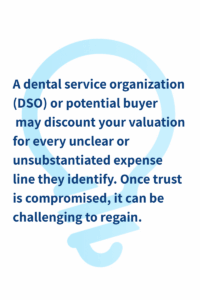Why This Matters to Dental Practice Owners
Whether you’re considering opening a second location, joining a Dental Service Organization, or planning to exit your practice in the next 5 to 10 years, your long-term success depends on more than just clinical outcomes. It hinges on how well your financial data tells your story.
Most dental practice owners, rightly focused on patient care, staff management, and meeting production goals, often overlook a crucial question:
“Is my practice financially structured for growth or exit?”
If this question gives you pause, you are not alone.. This is an ideal moment to assess whether your financial systems support your vision or unintentionally hold it back.
Relying solely on bank balances, gut feelings, or QuickBooks to manage your practice can become a liability. Instead, you need specialized accounting tailored for dental practice growth that transforms your financial data into a strategic asset.
Running a “Profitable” Practice Without a Scalable Financial System
Imagine that your production numbers are strong, collections are consistent, and payroll feels manageable. On the surface, everything appears fine.
But if you lack a clear understanding of your true profitability EBITDA(Earnings Before Interest, Taxes, Depreciation, and Amortization), have unorganized historical data, or don’t track standardized Key Performance Indicators (KPIs), your practice may present itself as a financial mystery to outside stakeholders. And a mystery translates to risk.
This becomes particularly problematic when you are:
- Preparing for an acquisition or DSO roll-up
- Securing financing for expansion
- Onboarding an associate or junior partner
- Planning for a future transition
Frequently, practices that seem strong clinically may be undervalued financially, not because they are underperforming, but because their financials do not convey a clear message.
Accounting for dental practice growth isn’t about completely changing what works; it’s about organizing your financial data to demonstrate value, instil confidence and support smarter decision-making.
How Strategic Accounting Supports Practice Growth
Let’s explore what modern, specialized dental accounting entails and how it can help you shift from “it’s working” to “it’s scalable.”
Dental-Specific KPI Tracking: Generic Reports Aren’t Enough
You shouldn’t have to sift through a P&L statement to determine whether your hygiene program is underperforming or if your cost per chair is increasing.
Instead, you need tailored metrics that accurately reflect dental economics, such as:
- Chair utilization rate
- Production per provider
- Overhead as a percentage of collections
- Hygiene-to-restorative ratio
- Patient acquisition cost
These KPIs do more than simply provide information; they drive operational decisions, highlight inefficiencies, and form the backbone of your practice’s valuation during sale discussions.
Practices that track KPIs monthly are three times more likely to make profitable adjustments before a transition period.
Clean EBITDA: The Key Metric for Buyers and Lenders
EBITDA is the industry standard for valuing a dental practice. However, most financial statements include personal expenses, family salaries, auto leases, or one-time costs that can obscure the true financial picture.
A strong accounting team will:
- Normalize financial statements
- Add back non-operational costs
- Reclassify expenses for clarity
Addressing these issues isn’t something to leave until the last minute; ideally, you should begin cleaning up your EBITDA at least 12 to 24 months before any exit discussions commence.
Why Excel and Desktop Tools Don’t Support Growth
As you transition from one office to two, or if you’re planning to expand into a group practice, your systems need to be able to grow with you.
The right infrastructure should include:
-
Cloud-based accounting software with dental integrations:
Modern dental practices require more than just basic accounting tools. Cloud-based solutions offer unparalleled flexibility, accessibility, and real-time data insights. Crucially, these platforms should seamlessly integrate with existing dental practice management software (PMS) to streamline operations, automate data entry from patient billing and insurance claims, and provide a holistic financial overview. This integration minimizes manual errors, enhances data accuracy, and frees up valuable administrative time.
-
Automated accounts payable and reconciliation workflows:
Manual processing of invoices and bank reconciliations is time-consuming and prone to errors. Implementing automated workflows for accounts payable ensures timely payments, better cash flow management, and improved vendor relationships. Similarly, automated reconciliation processes eliminate the painstaking task of matching transactions and providing accurate and up-to-date financial records. These automations are critical for maintaining clean books and preparing for due diligence during growth phases or an eventual exit.
-
A fractional finance team and CFO support as needed:
As a dental practice grows, its financial complexities multiply. A dedicated in-house finance team can be cost-prohibitive for many practices. A fractional finance team provides access to expert financial guidance and operational support on an as-needed basis.
- Bookkeepers are responsible for the day-to-day recording of financial transactions, ensuring accurate and organised data.
- Controllers oversee the accounting operations, prepare financial statements, and ensure compliance with accounting standards.
- Fractional CFOs offer strategic financial planning, budgeting, forecasting, and M&A advisory, crucial for scaling operations, identifying growth opportunities, and preparing the practice for a profitable exit. This tiered support model ensures that the practice has the right level of financial expertise at each stage of its growth.
The overarching goal of establishing this robust infrastructure is clear: to spend less time fixing reports and more time acting on them. By automating routine tasks and leveraging expert financial insights, practice owners can shift their focus from reactive problem-solving to proactive strategic decision-making.
What to Expect During Exit Planning And Why Start Planning Early
-
Multi-year Financial Comparisons:
Buyers will meticulously analyze your financial statements over several years, typically the past three to five. This includes profit and loss statements, balance sheets, and cash flow statements. They are looking for consistent revenue growth, manageable expenses, and healthy profit margins. Any significant fluctuations or inconsistencies will raise red flags and require thorough explanations. A clear, upward trend in key financial metrics is highly desirable.
-
Validation of Payroll Taxes and Accounts Receivable:
Accuracy and compliance are paramount. Buyers will want to see irrefutable proof that all payroll taxes have been correctly calculated, paid on time, and properly documented. Similarly, they will scrutinize your accounts receivable to assess their collectability and overall health. A high percentage of uncollectible or aged receivables can significantly devalue your practice, as it signals potential issues with billing, collection processes, or even patient retention.
-
Consistency in Collections and Overhead:
Stability in these areas speaks volumes about the operational efficiency and profitability of your practice. Buyers look for predictable and strong collection rates, indicating effective financial management and patient compliance. Equally important is consistent and well-managed overhead. Unexplained spikes or dips in operating costs can suggest inefficiencies or underlying problems. Demonstrating a tight ship in both collections and overhead management instils confidence in a buyer regarding the practice’s ongoing financial viability.
-
Clean Documentation Regarding Provider Pay and Associate Compensation:
Transparent and meticulously organized records of all provider compensation, including your own, as well as associate salaries, bonuses, and benefits, are critical. This ensures clarity on one of the largest expense categories for any dental practice. Buyers will want to understand the structure of compensation, any contractual obligations, and how these costs align with revenue generation. Any ambiguity or missing documentation in this area can lead to delays, renegotiations, or even scuttle a deal.
Starting early allows you to identify and address any weaknesses or areas for improvement well in advance of a potential sale. It provides ample time to clean up financial records, streamline operations, and ultimately position your practice for a smooth and successful exit. Waiting too long to start this process can limit your options and may reduce your practice’s valuation.
Why This Matters for You
You’ve built something meaningful through years of clinical skill, patient loyalty, and relentless effort. However, if your financial structure can’t communicate that value, others won’t recognize it.
Accounting isn’t just about numbers; it’s the language of your practice. During moments of growth or transition, it needs to speak clearly.
Whether you’re considering opening a second location, evaluating partnership models, or simply wanting better visibility, accounting for dental practice growth isn’t a luxury; it’s a foundational tool for confident leadership.
What You Can Start Doing Today
Here are three steps you can take in the next 90 days to improve your financial readiness without overhauling your entire system:
- Track dental KPIs monthly, even if you start with just three core metrics.
- Clean up your chart of accounts to eliminate ambiguity and misclassification.
- Start separating personal and business expenses; think like a buyer.
If expansion or an exit strategy is on the horizon, begin laying the financial foundation now. Your future self and your future buyer will appreciate it. 
Contact our Dallas office for a complimentary CFO consultation to explore the benefits of Fractional Accounting with Bright Balance today!





